nn
n
n
n
n Hand in hand with Christmas Pudding comes Christmasnpie. These are usually known as Mince Pies, although some modern folk find itnstrange that a pie containing no minced meat can be called a mince pie. Therenare two reasons for this. In the past, ‘meat’ was a term for any food, by whichnmeaning we still use it in such phrases as, ‘It’s all meat and drink to me’.nThe other reason is that, in the past, mince pies did contain meat (and somenstill do, if you count beef suet as meat – it is animal fat, after all).
n
n
n
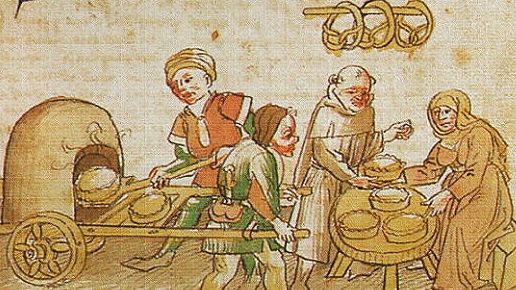 |
| Pyes in the Oven |
n
n
n
nAsnwinter approached and animal feed grew scarcer, it was common to slaughternlivestock towards the end of the year, eliminating the need to feed themnthrough the winter months. However, preserving meat in the past was not ansimple process; some meat could be smoked, some preserved in brine or salted,nsome could be cured in other ways or dried, and some could be preserved innsugars. This meant either in fruit sugars or honey, and various methods werenemployed.
n
n
n
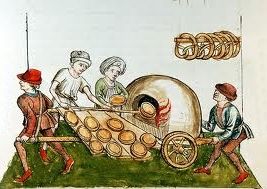 |
| More pyes in the oven |
n
n
n
nSome included using spices to flavour the meat but this was not anmethod of disguising the taste of meat that was past its best. I’ve mentioned this before, but it’s such a widespread myth that I’ll say it again. In thenpast, spices were phenomenally expensive, often worth more than their weight inngold. They had to be imported from the East, either overland via the MiddlenEastern merchants or by sea, in sailing ships that had to risk sailing aroundnthe southern capes. If you could afford spices, you would not waste them onnropy meat. Spices were a conspicuous display of your wealth and were used tonimpress your friends and neighbours. They were not used to cover up the tastenof bad meat.
n
n
n
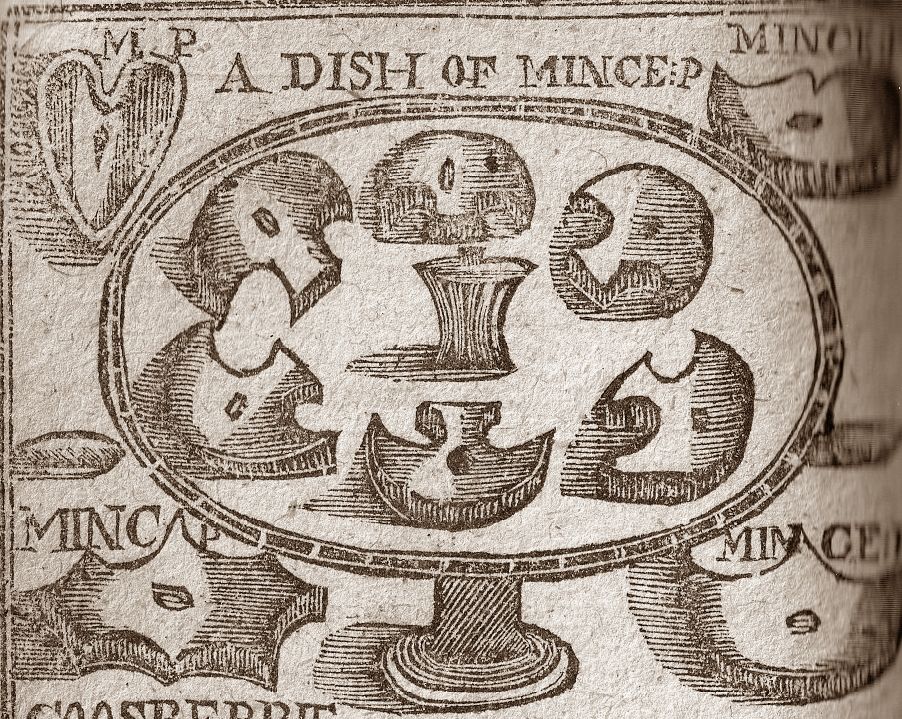 |
| Mince Pyes |
n
n
n
nI have also mentioned that mixing meat and fruit may sound odd,nbut it has a long history. We happily put pineapple in sweet and sour dishes,nserve roast pork with apple sauce, turkey with cranberries, duck with orange,nlamb with apricots and so forth. The fruit sugars were used to add flavour andnalso to preserve meats, in the days before reliable refrigeration. Meat andnfruit would be baked in pies, the crusts of which were called ‘coffins’, andnwere sometimes called ‘shrids’ or ‘minched pyes’. In Sheppard’s Epigramsn(1651), is this short verse,
n
n
n
n“No matter for Plomb-porridge,or Shrid-piesnnn
nnOr a whole Oxe offered in sacrificennn
nnTo Comus, not to Christ.”n
n
n
n
n
 |
| Serving the Pie |
n
n
n
nAnother verse, entitled ThenReligion of the Hypocritical Presbyterians in meeter, (1661) reads,
n
n
n
n“ThreenChristmass or Minc’d Pies, all very fair,n
nMethought they had this Motto, Thoughnthey flirt usn
nAnd preach us down, ‘sub pondere crescit virtut’.n
n(i.e. Under thenweight of growing virtue).n
n
n
nThe Puritans, as I have mentioned, regarded all thentraditional Christmas foods as vain gluttonies, and railed against,
n
n
n
n“…nChristmas Pye as an invention of the scarlet whore of Babylon, an hodge-podgenof superstition, popery, the devil, and all his works.”n
n
n
nSome say that ‘mincenpie’ is a Puritanism and they ought really to be called Christmas Pies – thenPuritans objected to the word Christmas which they associated with the PopishnChrist’s Mass, and they also called them Nativity pies. Thankfully, there werenopponents to the killjoys, as in this parody,
n
n
n
n“The high-shoe lords of Cromwell’snmakingnnn
nnWere not for dainties — roasting, baking;nnn
nnThe chiefest food they found most good innnn
nnWas rusty bacon and bag pudding;nnn
nnPlum-broth was popish, and mince-pie —nnn
nnO that was flat idolatry!”n
n
nnn
n
n
n
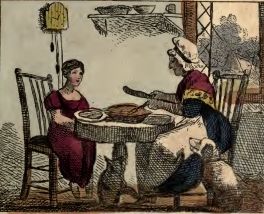 |
| Cutting a Pie |
n
n
n
nThe Puritans failed in their bid to outlaw Christmasn(although you may occasionally hear the (false) urban myth that mince pies arenstill illegal in England), and Henri Misson, in his Travels in England (1719),nnotes,
n
n
n
n“Every family against Christmass makes a famous pye, which they callnChristmas Pye. It is a great nostrum, the composition of this pasty: it is anmost learned mixture of neat’s-tongues, chicken, eggs, sugar, raisins, lemonnand orange peel, various kinds of spicery, &c.”n
n
n
nThe early pies were bakednin the shape of a crib or manger, and a figure of the Christ Child moulded fromnpastry was placed on top – this was called the Yule Dough or Dow (the practicenhad fallen into disuse by 1813, according to John Brand’s Observations onnPopular Antiquities). Once sugar became more readily available, particularlynfrom the Americas, the division in English cookery between sweet and savourynfoods became more pronounced, with mince pies gravitating towards the sweet endnof the spectrum.
n
n
n
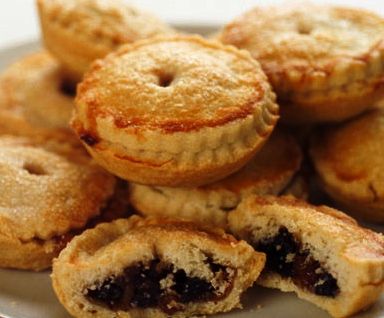 |
| Minced Pies |
n
n
n
nModern mince pies may contain suet, but also contain a mixturenof dried and candied fruits, peels, citron, raisins, spices, brandy, sherry,ncherries, figs and so on; the most traditional recipes contain thirteenningredients, symbolising Christ and his twelve apostles. Mince meat may be madenwell in advance of Christmas and improves in taste as it matures and ages.
n
n
n
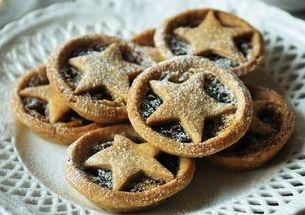 |
| Even more Mince Pies |
n
n
n
nThenpies may be closed or open topped and can be served hot or cold, either onntheir own or together with a topping such as cream, custard or ice-cream. Onenold tradition is to eat a mince pie on every one of the twelve days ofnChristmas, each in a different house, which will bring luck to all of them.
n
n
n
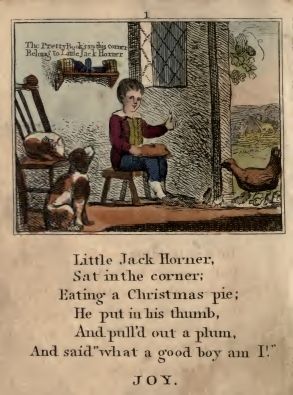 |
| Little Jack Horner |
n
n
n
nThere is a story that began to circulate during the nineteenth century thatnduring the dissolution of the monasteries under Henry VIII, the last abbot ofnGlastonbury Abbey, Richard Whiting, sought to sway and delight the King bynsending him a Christmas pie in which he had hidden the deeds to twelve of thenAbbey’s choicest estates. He sent the pie with one of his agents, ThomasnHorner, who, during his journey to London, opened the pie and purloined thendeeds to the manor of Mells, in Somerset, for himself. Henry dissolvednGlastonbury Abbey anyway, Whiting was brutally slaughtered on trumped-upncharges of treason, and Horner took possession of Mells, where his descendantsnstill live. They say that the story is just that – a story – and their ancestornbought the manor from the crown, but the tale has come to be regarded as theninspiration for the nursery rhyme of Little Jack Horner, who pulled a ‘plum’n(i.e. Mells) from a pie. There is a couplet from the time that circulated innSomerset (and beyond) at the time,
n
n
n
n“Horner, Popham, Wyndham, and Thynne,n
nWhennthe abbot came out, then they went in.”n
n
nnn
n
 |
| A Pair of Mince Pies (that’s rhyming slang for eyes). |
n
n
